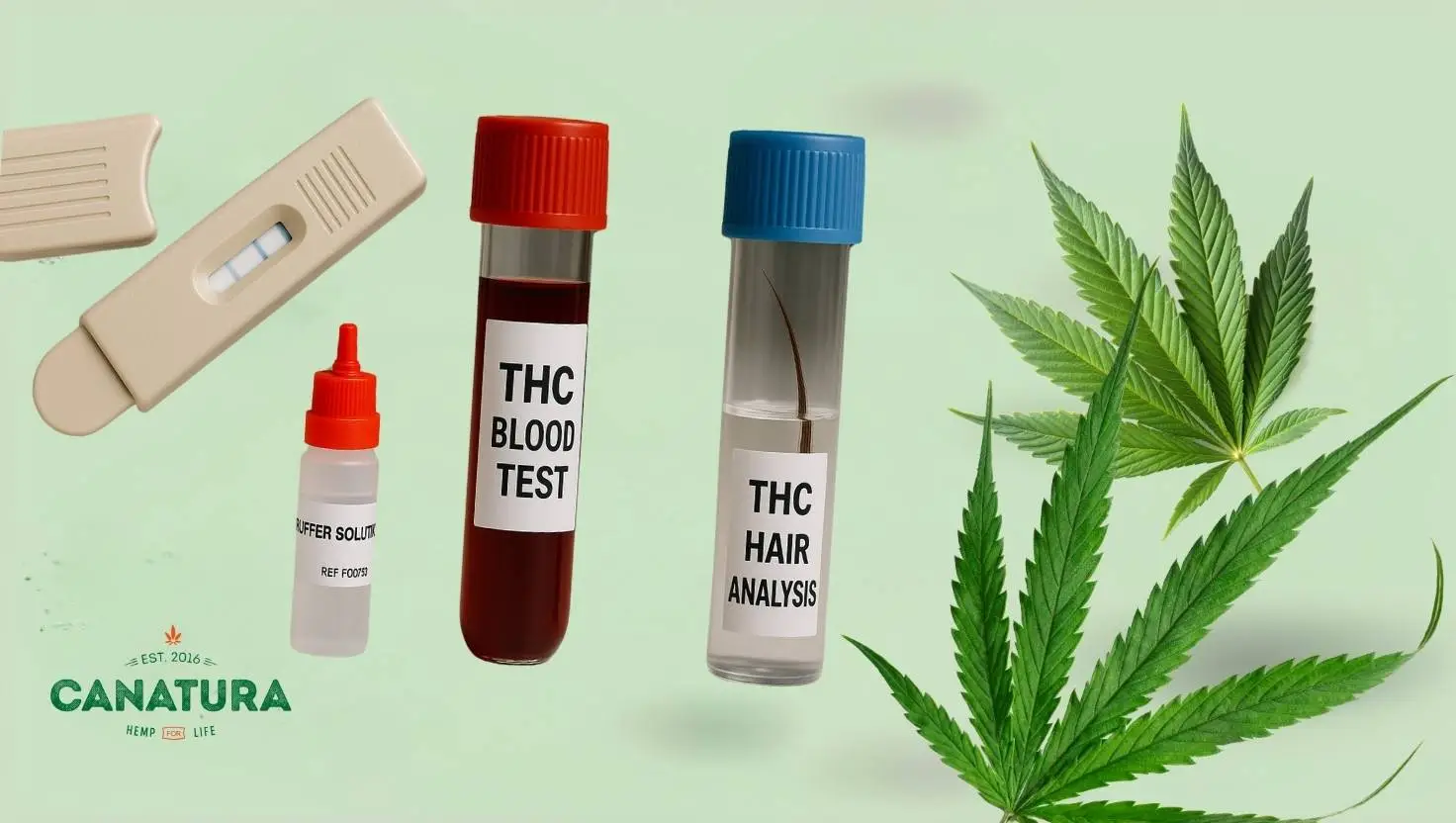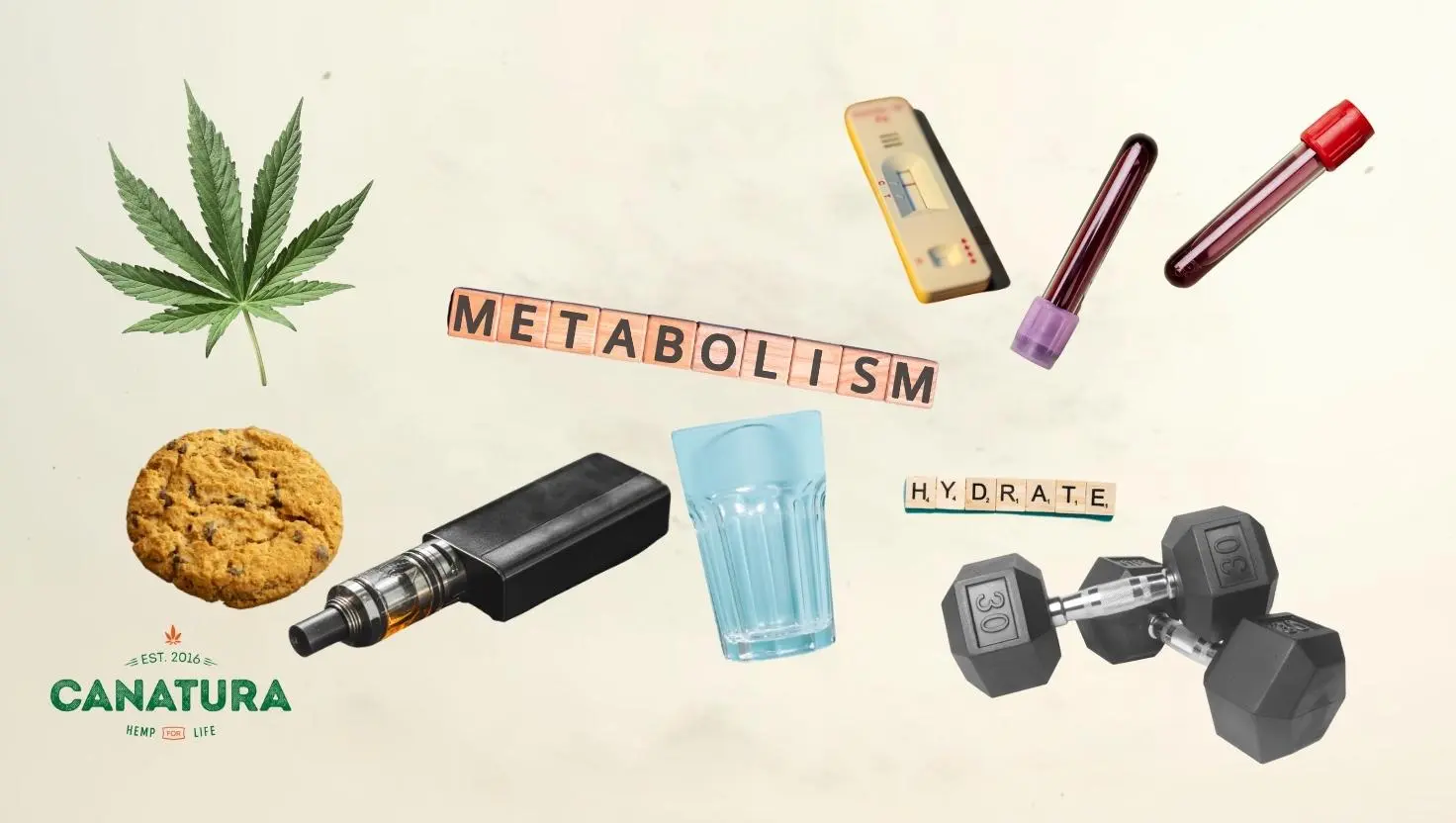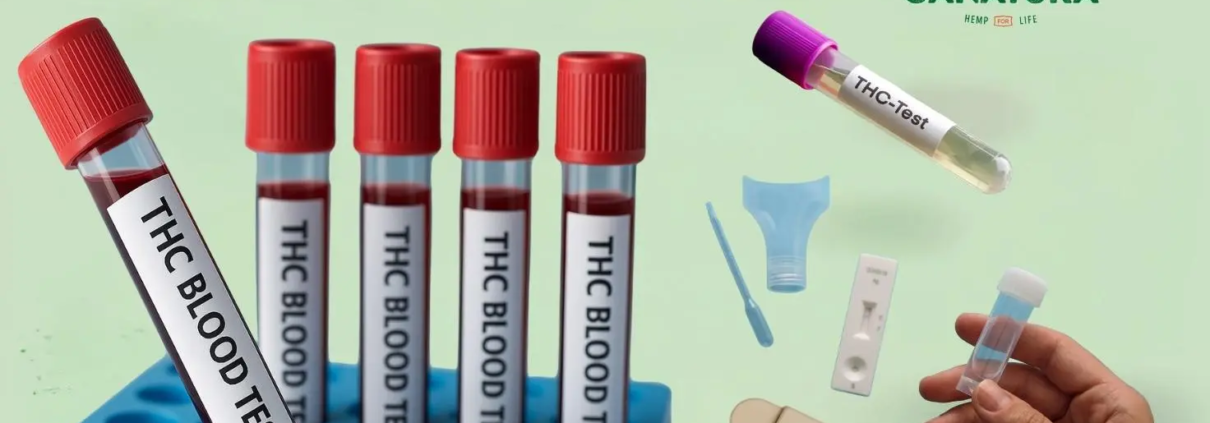How long does THC (not only) stay in the blood and what factors influence this? Overview of measurement methods
- What is THC and how does it affect the body?
- What are the methods for detecting THC?
- Detection of THC in the blood
- Legislation in Europe: THC and driving
- Conclusion
- FAQ
What is THC and how does it affect the body?
THC (delta-9-tetrahydrocannabinol, delta-9-THC, Δ⁹-THC) is the main psychoactive component of the cannabis plant. Compounds that are structurally similar to THC are called cannabinoids (e.g. CBD, CBG, CBN and others).
More than 150 cannabinoids have already been discovered in the cannabis plant. Some of them, such as THC, have psychoactive properties, others, such as CBD, do not cause changes in perception.
THC is widely known to affect CB1 and CB2 receptors in the endocannabinoid system. It acts primarily on CB1 receptors in the brain and thus affects the psyche.
THC induces euphoria, relaxation, changes in the perception of time and space or increased appetite. At the same time, however, it reduces cognitive and motor skills and, like alcohol, affects coordination and attention.

What are the methods for detecting THC?
Several types of tests are used to detect THC and its metabolites in the body. Each of these methods differs in the length of the detection window and the reliability of the results.
Blood tests
Blood tests are the most reliable way to determine the actual presence of THC. Blood tests detect mostly active THC circulating in the blood, so they will show recent consumption.
They are accurate, but the detection window is quite short – THC is detectable in the blood within a few hours at most (usually within 24 hours) for one-time users and a few days for regular users.
Saliva tests
Saliva tests are mainly used as a screening method (orientation test). They are quick, non-invasive and commonly used for example in roadside checks.
They detect THC in the oral cavity and saliva, so like blood tests, they can show recent use. Usually THC can be detected from these tests 6-24 hours after consumption, or up to 30 hours for strong doses or sensitive tests.
Saliva tests cannot determine the exact concentration of THC in the blood – a positive result is used as a basis for further testing (blood test).
Experts point out that saliva test results are quite often not consistent with blood test results and that the accuracy of saliva tests is lower compared to blood tests.
Urine tests
Urine tests are most common in occupational medicine practice and in withdrawal or anti-doping controls.
It is not THC itself that is sought in the urine, but its main metabolite, 11-nor-9-carboxy-THC (THC-COOH), which is produced in the liver and gradually excreted by the kidneys. This metabolite may be detectable in the urine for several days to weeks depending on the intensity of use – approximately 1 to 30 days after the last use.
The detection window also depends on the intensity of use – typically 3-7 days for a single user, 1-4 weeks for frequent users, and rarely longer.
Sweat test
Sweat test are a less common method, but can be encountered, for example, in roadside inspections. Special patches are used to capture THC metabolites in sweat.
Metabolites in sweat can be detected for days to weeks.
Hair analysis
Hair analysis will detect THC use even several months in the past, as the metabolites are deposited in the hair fibre. It is used to detect long-term or repeated use.
This type of measurement is usually used, for example, in forensic and forensic investigations, abstinence monitoring or in professions with high responsibilities.

Detection of THC in the blood
To detect THC in the blood, a blood sample is taken and then analysed in a laboratory by toxicological analysis.
Blood tests are used as a confirmatory method, for example, if a driver fails an indicative saliva or sweat road test, a medical examination followed by a blood test for laboratory determination of THC levels.
The result of the blood test is of the highest evidentiary value – in court proceedings, it is the toxicological blood test that is decisive, not the orientation test.
As mentioned, blood tests detect active THC (proving recent use) and can accurately measure the concentration of THC in the body, expressed in nanograms per millilitre (ng/ml).
How long does THC stay in the blood?
In general, THC (the active form) persists in the blood for a significantly shorter period of time than the inactive metabolites, which circulate and are stored in the body for a longer period of time.
Blood tests are the most accurate method of testing for current intoxication, with active THC usually remaining in the blood for no more than 24 hours. The length of time that THC can be detected in the blood depends on many factors.
What factors determine how long THC can be detected in the blood?
Some of the key factors that affect how long THC stays in the blood are the dose of THC and the frequency of use.
In general, the higher the amount and the more frequent the consumption, the longer THC can be detected in the blood (not only). Regular users have measurable levels for longer than occasional users.
Other factors that affect the detection time of THC in the blood:
- THC concentration in cannabis: The amount of THC in cannabis or concentrated extracts affects the amount of substance ingested – stronger strains or concentrates may leave more metabolites and extend the detection window.
- Method of use: for example, when taken orally (edibles), the onset and elimination of effects differ from vaporisation or smoking.
- Metabolism and body composition: THC is stored in body fat, so people with a higher proportion of fat break it down more slowly. Conversely, a fast metabolism (due to genetics, fitness or age, for example) contributes to faster elimination from the body.
- Level of hydration and physical activity: dehydration can increase the measured THC concentration in the blood, whereas vigorous exercise can help regular users release THC from fat stores back into the circulation immediately after activity.
- Type and sensitivity of the test: different test methods and instruments have different detection limits (cut-offs).
Dose and frequency of use remain the most important factors. Acute THC intoxication lasts only a few hours, but the presence of the substance in body fluids can be detected for days or weeks.
The presence of THC in the blood can have legal consequences for both the driver and the employee – including criminal liability for impaired driving.

Legislation in Europe: THC and driving
Legislation on THC, particularly in relation to driving, is not uniform across the European Union, with individual countries taking their own approaches. In general, the approach applied in Europe is – very strict zero-tolerance regulation or setting very low THC limits (0.3–3 ng/mL) for drivers.
In practice, this means that even the minimum detectable amount of THC in the driver is considered unacceptable.
Conclusion
A blood test detects mainly current or recent intoxication (hours to days), while sweat or saliva test detect THC within hours to days. A urine test will detect recent and relatively recent use (days to weeks depending on frequency), while a hair analysis will detect a history of use over several months.
Several factors influence how long THC stays in the blood, especially the dose and frequency of use. The length of time the substance remains in the blood varies from user to user and depends on the factors already mentioned.
FAQ
See also the other questions you are most interested in regarding this topic.
How does THC enter the body and how long does it stay in the body?
THC is absorbed into the blood either by vaporisation, smoking or ingestion and then metabolised in the liver.
Due to the high fat solubility of THC, it and its metabolites can accumulate in adipose tissue and be released gradually, so that THC can remain detectable in the body long after the acute effects have worn off, especially in regular users.
The length of detection depends mainly on the dose and frequency of use. Factors such as the THC concentration of cannabis, the method of consumption, the user’s metabolism, body composition, degree of hydration, physical activity and the sensitivity of the particular test also have an influence.
Which tests show acute THC intoxication?
The most reliable test to detect acute intoxication is a blood or saliva test. These tests detect recent THC use.
How do police test for THC during roadside checks?
Police use several methods to test drivers and suspects for THC. The most commonly used method during roadside checks is the saliva or sweat test.
The blood test usually follows the screening test and is used as evidence in the event of a positive screening test result.
What effect does CBD have on driving?
CBD, or cannabidiol, is considered a safe substance for everyday use. Unlike THC, it has no psychoactive effects and does not induce a state of intoxication.
For example, a 2020 study reported that even high doses of CBD (up to 1 500 mg) did not affect cognitive function or driver performance.
Another study analysed the simulated driving performance of 17 participants after taking a placebo and three different doses of CBD (15 mg, 300 mg and 1 500 mg) and concluded that none of these doses induced a feeling of intoxication or impaired driving or cognitive performance.
It should be added that reactions to CBD can be individual.
Some users may experience calming effects that could theoretically affect their ability to react quickly when driving. Therefore, it is recommended that each driver assess for themselves how CBD affects them and, if in any doubt or if a negative effect is noticed, avoid using CBD before driving.
Can CBD show up on drug tests?
Conventional tests look for THC and its metabolites, not CBD. However, full-spectrum CBD products contain trace amounts of THC (0.2-0.3%) that could show up in a test, especially with regular use.
Drivers should therefore reach for broad-spectrum CBD products or CBD isolates that do not contain any THC.
Sources:
- who.int/teams/mental-health-and-substance-use/alcohol-drugs-and-addictive-behaviours/drugs-psychoactive/cannabis
- healthline.com/health/how-long-does-weed-stay-in-your-system
- drugs.com/lifestyle/how-long-does-marijuana-stay-in-system
- euda.europa.eu/publications/drug-profiles/cannabis
- medicalnewstoday.com/articles/324315
- pracepropravniky.cz/zakony/trestni-zakonik-uplne-zneni/paragraf-274
- testing.com/tests/marijuana-thc-testing
- injepijournal.biomedcentral.com/articles/10.1186/s40621-014-0026-z/tables/2
Author: Patricie Mikolášová
Photo: AI
“All information provided on this website, as well as information provided through this website, is for educational purposes only. None of the information contained herein is intended to be a substitute for a medical diagnosis and should not be considered medical advice or recommended treatment. This website does not endorse, condones or advocate the licit or illicit use of narcotic drugs or psychotropic substances or the commission of any other illegal activity. For more information, please see our Disclaimer .”


